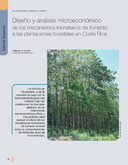| dc.contributor.author | Navarro, Guillermo A. | |
| dc.date.accessioned | 2015-03-19T21:18:02Z | |
| dc.date.available | 2015-03-19T21:18:02Z | |
| dc.date.issued | 2004-11 | |
| dc.identifier.issn | e-ISSN: 1659-1216 | es_EN |
| dc.identifier.uri | https://repositorio.catie.ac.cr/handle/11554/6058 | |
| dc.identifier.uri | 473153 | es_ES |
| dc.description.abstract | Esta investigación presenta una aplicación rigurosa de la fórmula del valor esperado de la tierra (VET) -comúnmente conocida como la fórmula de Faustmann1- la cual es un modelo económico simple pero teóricamente robusto, utilizado en la valoración y análisis económico de inversiones forestales. El primer producto del estudio es desarrollar un soporte teórico para la valoración de inversiones en plantaciones forestales y contabilizar correctamente mecanismos monetarios de fomento forestal como el certificado de abono forestal, el crédito subsidiado y el pago por servicios ambientales.El análisis inicial demuestra que los diferentes mecanismos monetarios de fomento forestal pueden afectar la decisión del inversionista sobre el turno de rotación de la plantación forestal y que, además, afectan la rentabilidad de la inversión forestal. Finalmente, se evalúan algunos factores de la producción forestal (precio de la tierra, precio implícito de la madera en pie y cambio de especie forestal) para ver su efecto sobre la rentabilidad de las inversiones forestales. | es_ES |
| dc.description.abstract | This research presents a rigorous application of the land expectation value formula (LEV) -commonly known as the Faustmann Formula- which is a simple yet robust economic model used in valuation and economic analysis of forestry investments. The first product of this study was to develop a technical support for valuing investments in forest plantations and to correctly account for the monetary mechanisms for forest promotion such as the forest bond, the subsidized credit and the payment of environmental services. This initial analysis shows that all monetary mechanism not only affect the investor’s cutting decisions for their forest stand, but also affect the profitability of the forestry investment. Finally, some factors of the forest production cycle (land price, stumpage implicit price, and forest species) are evaluated in order to measure their influence in the profitability and optimal rotation age of the forest investments. | |
| dc.format.extent | 13 páginas | |
| dc.format.mimetype | pdf | |
| dc.language.iso | es | es_ES |
| dc.publisher | CATIE, Turrialba (Costa Rica) | es_ES |
| dc.publisher | CATIE, Turrialba (Costa Rica) | |
| dc.relation.ispartof | Recursos Naturales y Ambiente Número 43 (Noviembre 2004), páginas 36-48 | |
| dc.rights.uri | https://creativecommons.org/licenses/by-nc-nd/4.0/ | |
| dc.subject | INVERSIONES ANALISIS | |
| dc.subject | ECONOMICO | |
| dc.subject | VALOR ECONOMICO | |
| dc.subject | INCENTIVOS | |
| dc.subject | DESARROLLO FORESTAL | |
| dc.subject | MICROECONOMIA | |
| dc.subject | SERVICIOS AMBIENTALES | |
| dc.subject | COSTA RICA | |
| dc.subject | PLANTACION FORESTAL | es_ES |
| dc.title | Diseño y análisis microeconómico de los mecanismos monetarios de fomento a las plantaciones forestales en Costa Rica | es_ES |
| dc.title.alternative | Design and microeconomic analysis of the monetary mechanisms from promotion to the forest plantations in Costa Rica | es_ES |
| dc.type | Artículo | es_ES |
| dc.journal.issueNumber | 43 | |
| dc.journal.pages | 36-48 | |



